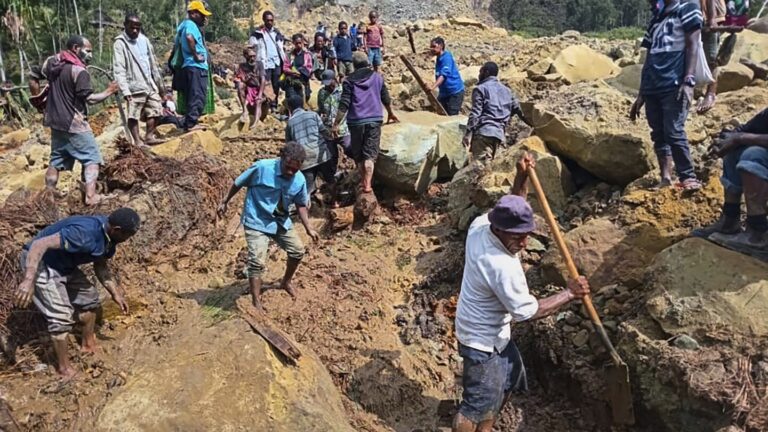MELBOURNE, Australia (AP) — The International Organization for Migration on Sunday raised its estimate of the death toll. Massive landslide hits Papua New Guinea The death toll rose to more than 670 as emergency workers and traumatized relatives gave up hope of finding any survivors.
Serhan Aktpulak, the head of the U.N. migration agency in the South Pacific island nation, said the revised death toll was based on calculations by Yambari village and Enga provincial authorities that more than 150 homes were buried in Friday’s landslide, up from an earlier estimate of 60.
“At this point, we estimate there are more than 670 people buried underground,” Aktoprak told The Associated Press.
Local authorities initially put the death toll on Friday at more than 100. By Sunday, only five bodies and the leg of a sixth victim had been recovered, with an excavator donated by a local construction company becoming the first of the earthmoving equipment deployed in the recovery effort.
Rescue teams were moving survivors to safety on Sunday amid frequent instability and tribal fighting in the Papua New Guinea highlands, threatening rescue efforts.
Officials said about 250 more homes have been destroyed as the ground is still shifting since the landslide, leaving an estimated 1,250 people homeless.
Meanwhile, the government is considering whether it needs to make a formal request for further international aid.
Rescuers have given up hope of finding survivors beneath the 6-8 metres (20-26 feet) of dirt and rubble.
“People are coming to terms with this and there is a great deal of sadness and grief,” Aktoprak said.
He said the new death toll was “not certain” because it was based on the average family size per household in the area, and he declined to speculate whether the actual toll could be higher.
“That’s difficult. We want to be pretty realistic,” Aktoprak said. “We don’t want to give numbers that overstate reality.”
Officials are setting up shelters in safer locations on either side of the massive debris pile that covers an area the size of three to four football fields and has blocked a major highway in the state.
Next to a closed highway Convoy The convoy, which has been delivering food, water and other supplies since Saturday to affected villages 60 kilometers (35 miles) from the provincial capital, Wabag, faces danger linked to inter-tribal fighting in the village of Tambitanis, about halfway along the route. Papua New Guinean soldiers were guarding the convoy.
Clashes between two rival clans over a long-standing dispute unrelated to the landslides left eight local residents dead on Saturday. About 30 homes and five shops were burned in the fighting, local authorities said.
Aktoprak said he did not expect tribal fighters to target the convoy, but noted criminals could take advantage of the confusion.
“This could essentially lead to carjackings and robberies,” Aktoprak said. “Not only are we concerned about the safety and security of personnel, but also the merchandise that people might take advantage of the chaos and steal.”
Years of tribal fighting have cast doubt on official estimates that the village had about 4,000 people living there when the slope of Mungaro Mountain collapsed. The estimates are several years old and do not take into account people who have recently moved to the village to escape tribal violence that government authorities have been unable to contain.
Justin McMahon, country director for humanitarian group CARE International, said moving survivors to “more stable ground” is an immediate priority, along with providing food, water and shelter. The military is leading those efforts.
The number of injured and missing was still being assessed as of Sunday. Seven people, including a child, had been treated by Saturday but authorities had no details about their condition.
Papua New Guinea’s Defense Minister Billy Joseph and Laso Mana, director of the government’s National Disaster Centre, travelled by helicopter from Port Moresby to Wabag on Sunday to see first-hand what is needed.
Aktoprak predicted the government would decide by Tuesday whether to formally request further international aid.
The United States and Australia, PNG’s neighbors and some of the country’s most generous foreign aid donors, are among the governments that have publicly said they are ready to provide additional support to relief workers.
Papua New Guinea is a diverse, developing country with 800 languages and a population of 10 million people, mostly subsistence farmers.

